German vs Russian Community Comparison
COMPARE
German
Russian
Social Comparison
Social Comparison
Germans
Russians
6,819
SOCIAL INDEX
65.7/ 100
SOCIAL RATING
140th/ 347
SOCIAL RANK
8,595
SOCIAL INDEX
83.4/ 100
SOCIAL RATING
62nd/ 347
SOCIAL RANK
Russian Integration in German Communities
The statistical analysis conducted on geographies consisting of 512,107,835 people shows a substantial positive correlation between the proportion of Russians within German communities in the United States with a correlation coefficient (R) of 0.569. On average, for every 1% (one percent) increase in Germans within a typical geography, there is an increase of 0.077% in Russians. To illustrate, in a geography comprising of 100,000 individuals, a rise of 1,000 Germans corresponds to an increase of 77.0 Russians.
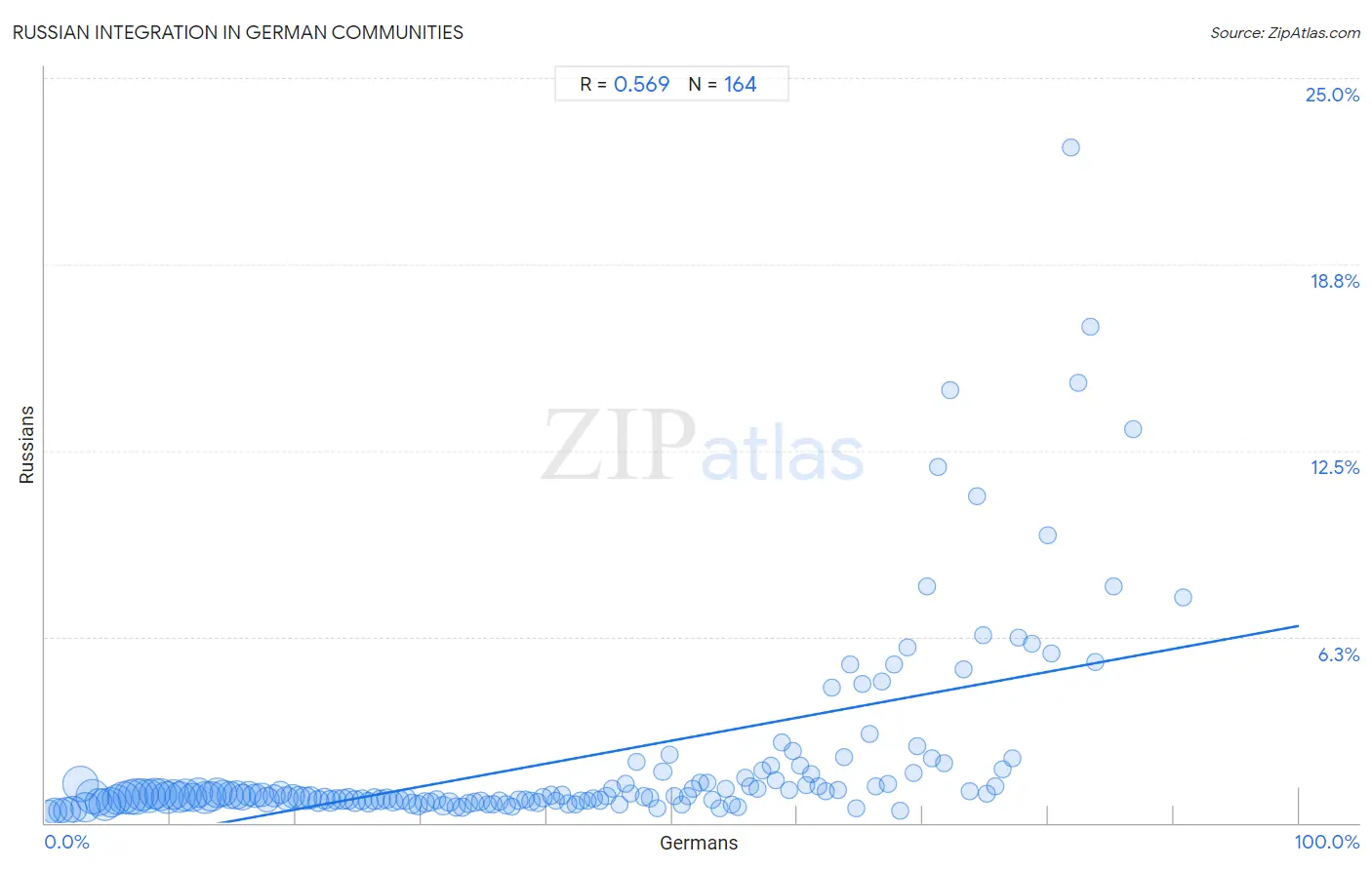
German vs Russian Income
When considering income, the most significant differences between German and Russian communities in the United States are seen in per capita income ($43,067 compared to $53,154, a difference of 23.4%), householder income ages 25 - 44 years ($93,531 compared to $110,398, a difference of 18.0%), and median family income ($102,254 compared to $120,487, a difference of 17.8%). Conversely, both communities are more comparable in terms of wage/income gap (29.2% compared to 28.0%, a difference of 4.2%), householder income under 25 years ($50,804 compared to $54,389, a difference of 7.1%), and householder income over 65 years ($59,730 compared to $67,626, a difference of 13.2%).

| Income Metric | German | Russian |
| Per Capita Income | Fair $43,067 | Exceptional $53,154 |
| Median Family Income | Average $102,254 | Exceptional $120,487 |
| Median Household Income | Fair $83,358 | Exceptional $98,008 |
| Median Earnings | Fair $45,935 | Exceptional $53,334 |
| Median Male Earnings | Good $54,974 | Exceptional $63,939 |
| Median Female Earnings | Tragic $37,986 | Exceptional $44,169 |
| Householder Age | Under 25 years | Tragic $50,804 | Exceptional $54,389 |
| Householder Age | 25 - 44 years | Fair $93,531 | Exceptional $110,398 |
| Householder Age | 45 - 64 years | Average $100,224 | Exceptional $116,328 |
| Householder Age | Over 65 years | Fair $59,730 | Exceptional $67,626 |
| Wage/Income Gap | Tragic 29.2% | Tragic 28.0% |
German vs Russian Poverty
When considering poverty, the most significant differences between German and Russian communities in the United States are seen in single female poverty (21.8% compared to 19.2%, a difference of 13.6%), female poverty among 25-34 year olds (13.6% compared to 12.1%, a difference of 12.7%), and seniors poverty over the age of 75 (10.4% compared to 11.6%, a difference of 12.5%). Conversely, both communities are more comparable in terms of receiving food stamps (9.7% compared to 9.6%, a difference of 1.1%), male poverty (10.1% compared to 9.9%, a difference of 2.2%), and poverty (11.1% compared to 10.9%, a difference of 2.6%).
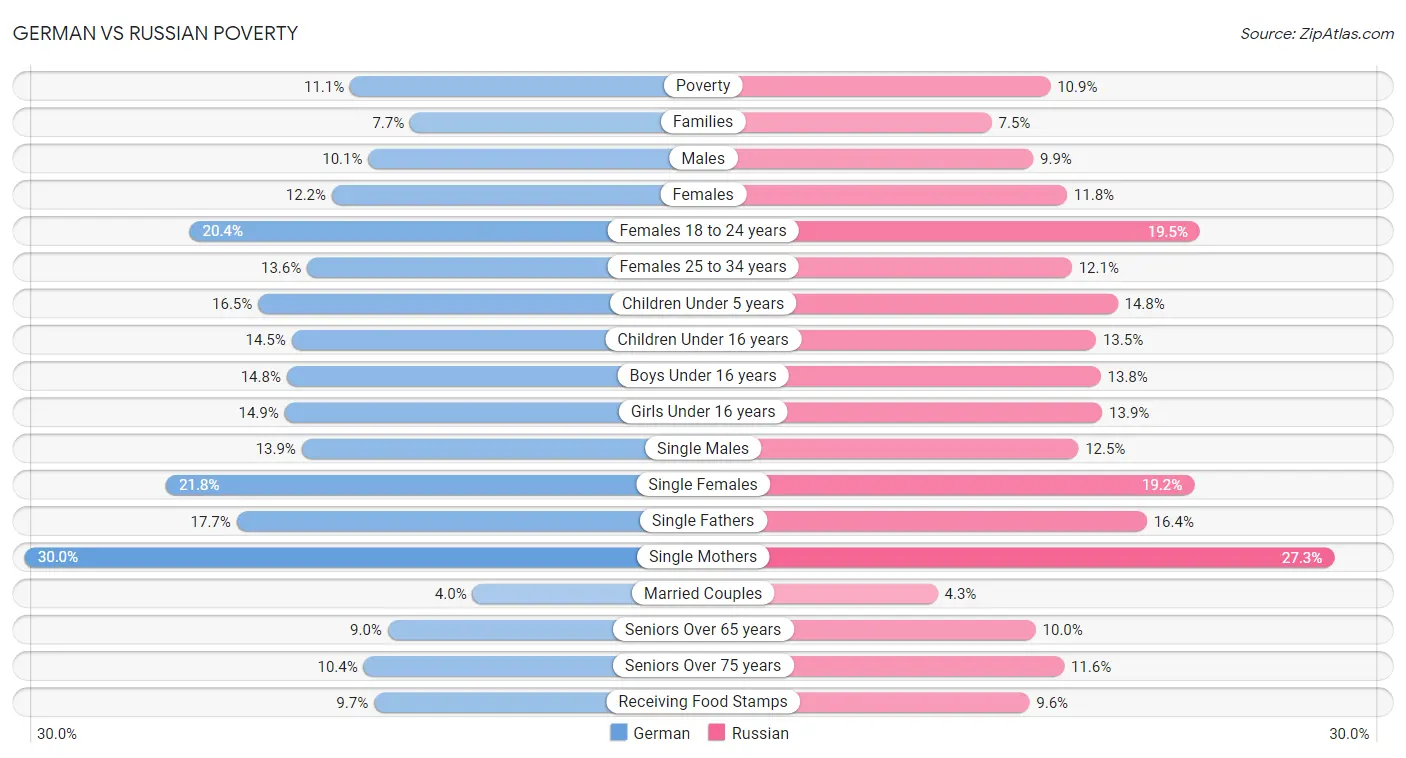
| Poverty Metric | German | Russian |
| Poverty | Exceptional 11.1% | Exceptional 10.9% |
| Families | Exceptional 7.7% | Exceptional 7.5% |
| Males | Exceptional 10.1% | Exceptional 9.9% |
| Females | Exceptional 12.2% | Exceptional 11.8% |
| Females 18 to 24 years | Fair 20.4% | Exceptional 19.5% |
| Females 25 to 34 years | Average 13.6% | Exceptional 12.1% |
| Children Under 5 years | Excellent 16.5% | Exceptional 14.8% |
| Children Under 16 years | Exceptional 14.5% | Exceptional 13.5% |
| Boys Under 16 years | Exceptional 14.8% | Exceptional 13.8% |
| Girls Under 16 years | Exceptional 14.9% | Exceptional 13.9% |
| Single Males | Tragic 13.9% | Excellent 12.5% |
| Single Females | Tragic 21.8% | Exceptional 19.2% |
| Single Fathers | Tragic 17.7% | Fair 16.4% |
| Single Mothers | Tragic 30.0% | Exceptional 27.3% |
| Married Couples | Exceptional 4.0% | Exceptional 4.3% |
| Seniors Over 65 years | Exceptional 9.0% | Exceptional 10.0% |
| Seniors Over 75 years | Exceptional 10.4% | Excellent 11.6% |
| Receiving Food Stamps | Exceptional 9.7% | Exceptional 9.6% |
German vs Russian Unemployment
When considering unemployment, the most significant differences between German and Russian communities in the United States are seen in unemployment among seniors over 75 years (10.3% compared to 8.9%, a difference of 15.5%), unemployment among ages 16 to 19 years (15.7% compared to 17.6%, a difference of 12.4%), and unemployment among women with children under 6 years (8.0% compared to 7.2%, a difference of 11.0%). Conversely, both communities are more comparable in terms of unemployment among ages 30 to 34 years (5.3% compared to 5.4%, a difference of 0.62%), unemployment among ages 25 to 29 years (6.5% compared to 6.6%, a difference of 2.8%), and unemployment among ages 35 to 44 years (4.3% compared to 4.5%, a difference of 3.1%).
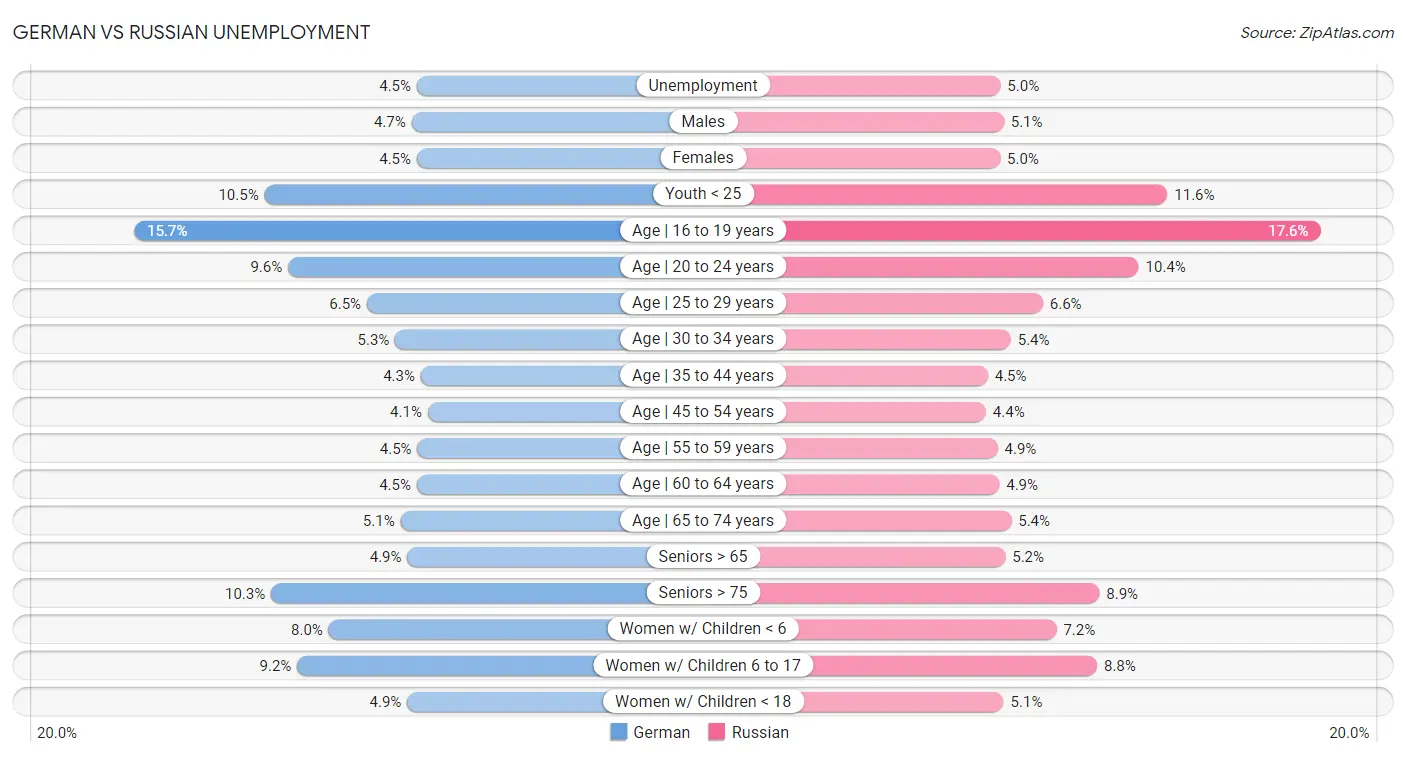
| Unemployment Metric | German | Russian |
| Unemployment | Exceptional 4.5% | Exceptional 5.0% |
| Males | Exceptional 4.7% | Exceptional 5.1% |
| Females | Exceptional 4.5% | Exceptional 5.0% |
| Youth < 25 | Exceptional 10.5% | Average 11.6% |
| Age | 16 to 19 years | Exceptional 15.7% | Average 17.6% |
| Age | 20 to 24 years | Exceptional 9.6% | Fair 10.4% |
| Age | 25 to 29 years | Excellent 6.5% | Average 6.6% |
| Age | 30 to 34 years | Good 5.3% | Good 5.4% |
| Age | 35 to 44 years | Exceptional 4.3% | Exceptional 4.5% |
| Age | 45 to 54 years | Exceptional 4.1% | Exceptional 4.4% |
| Age | 55 to 59 years | Exceptional 4.5% | Fair 4.9% |
| Age | 60 to 64 years | Exceptional 4.5% | Poor 4.9% |
| Age | 65 to 74 years | Exceptional 5.1% | Fair 5.4% |
| Seniors > 65 | Exceptional 4.9% | Average 5.2% |
| Seniors > 75 | Tragic 10.3% | Fair 8.9% |
| Women w/ Children < 6 | Tragic 8.0% | Exceptional 7.2% |
| Women w/ Children 6 to 17 | Tragic 9.2% | Excellent 8.8% |
| Women w/ Children < 18 | Exceptional 4.9% | Exceptional 5.1% |
German vs Russian Labor Participation
When considering labor participation, the most significant differences between German and Russian communities in the United States are seen in in labor force | age 16-19 (44.2% compared to 36.7%, a difference of 20.3%), in labor force | age 20-24 (78.6% compared to 74.8%, a difference of 5.0%), and in labor force | age 30-34 (84.8% compared to 85.5%, a difference of 0.77%). Conversely, both communities are more comparable in terms of in labor force | age 25-29 (85.3% compared to 85.3%, a difference of 0.090%), in labor force | age 35-44 (84.7% compared to 85.0%, a difference of 0.36%), and in labor force | age 45-54 (83.1% compared to 83.4%, a difference of 0.37%).

| Labor Participation Metric | German | Russian |
| In Labor Force | Age > 16 | Tragic 64.4% | Poor 64.9% |
| In Labor Force | Age 20-64 | Good 79.7% | Exceptional 80.0% |
| In Labor Force | Age 16-19 | Exceptional 44.2% | Average 36.7% |
| In Labor Force | Age 20-24 | Exceptional 78.6% | Fair 74.8% |
| In Labor Force | Age 25-29 | Exceptional 85.3% | Exceptional 85.3% |
| In Labor Force | Age 30-34 | Good 84.8% | Exceptional 85.5% |
| In Labor Force | Age 35-44 | Exceptional 84.7% | Exceptional 85.0% |
| In Labor Force | Age 45-54 | Excellent 83.1% | Exceptional 83.4% |
German vs Russian Family Structure
When considering family structure, the most significant differences between German and Russian communities in the United States are seen in single father households (2.4% compared to 2.0%, a difference of 18.6%), births to unmarried women (32.0% compared to 28.0%, a difference of 14.2%), and single mother households (5.8% compared to 5.3%, a difference of 8.9%). Conversely, both communities are more comparable in terms of average family size (3.09 compared to 3.12, a difference of 1.2%), family households (64.4% compared to 63.4%, a difference of 1.7%), and married-couple households (49.2% compared to 48.2%, a difference of 2.1%).

| Family Structure Metric | German | Russian |
| Family Households | Good 64.4% | Tragic 63.4% |
| Family Households with Children | Tragic 27.1% | Tragic 26.5% |
| Married-couple Households | Exceptional 49.2% | Exceptional 48.2% |
| Average Family Size | Tragic 3.09 | Tragic 3.12 |
| Single Father Households | Fair 2.4% | Exceptional 2.0% |
| Single Mother Households | Exceptional 5.8% | Exceptional 5.3% |
| Currently Married | Exceptional 49.6% | Exceptional 48.6% |
| Divorced or Separated | Tragic 12.5% | Exceptional 11.5% |
| Births to Unmarried Women | Fair 32.0% | Exceptional 28.0% |
German vs Russian Vehicle Availability
When considering vehicle availability, the most significant differences between German and Russian communities in the United States are seen in no vehicles in household (6.7% compared to 11.6%, a difference of 73.8%), 4 or more vehicles in household (7.5% compared to 6.0%, a difference of 24.6%), and 3 or more vehicles in household (22.7% compared to 18.8%, a difference of 20.7%). Conversely, both communities are more comparable in terms of 1 or more vehicles in household (93.6% compared to 88.7%, a difference of 5.6%), 2 or more vehicles in household (61.6% compared to 54.8%, a difference of 12.4%), and 3 or more vehicles in household (22.7% compared to 18.8%, a difference of 20.7%).

| Vehicle Availability Metric | German | Russian |
| No Vehicles Available | Exceptional 6.7% | Tragic 11.6% |
| 1+ Vehicles Available | Exceptional 93.6% | Tragic 88.7% |
| 2+ Vehicles Available | Exceptional 61.6% | Fair 54.8% |
| 3+ Vehicles Available | Exceptional 22.7% | Poor 18.8% |
| 4+ Vehicles Available | Exceptional 7.5% | Poor 6.0% |
German vs Russian Education Level
When considering education level, the most significant differences between German and Russian communities in the United States are seen in professional degree (4.1% compared to 6.3%, a difference of 55.1%), doctorate degree (1.8% compared to 2.6%, a difference of 43.1%), and master's degree (14.0% compared to 19.5%, a difference of 39.5%). Conversely, both communities are more comparable in terms of 12th grade, no diploma (93.3% compared to 93.2%, a difference of 0.11%), high school diploma (91.7% compared to 91.5%, a difference of 0.21%), and nursery school (98.7% compared to 98.4%, a difference of 0.34%).
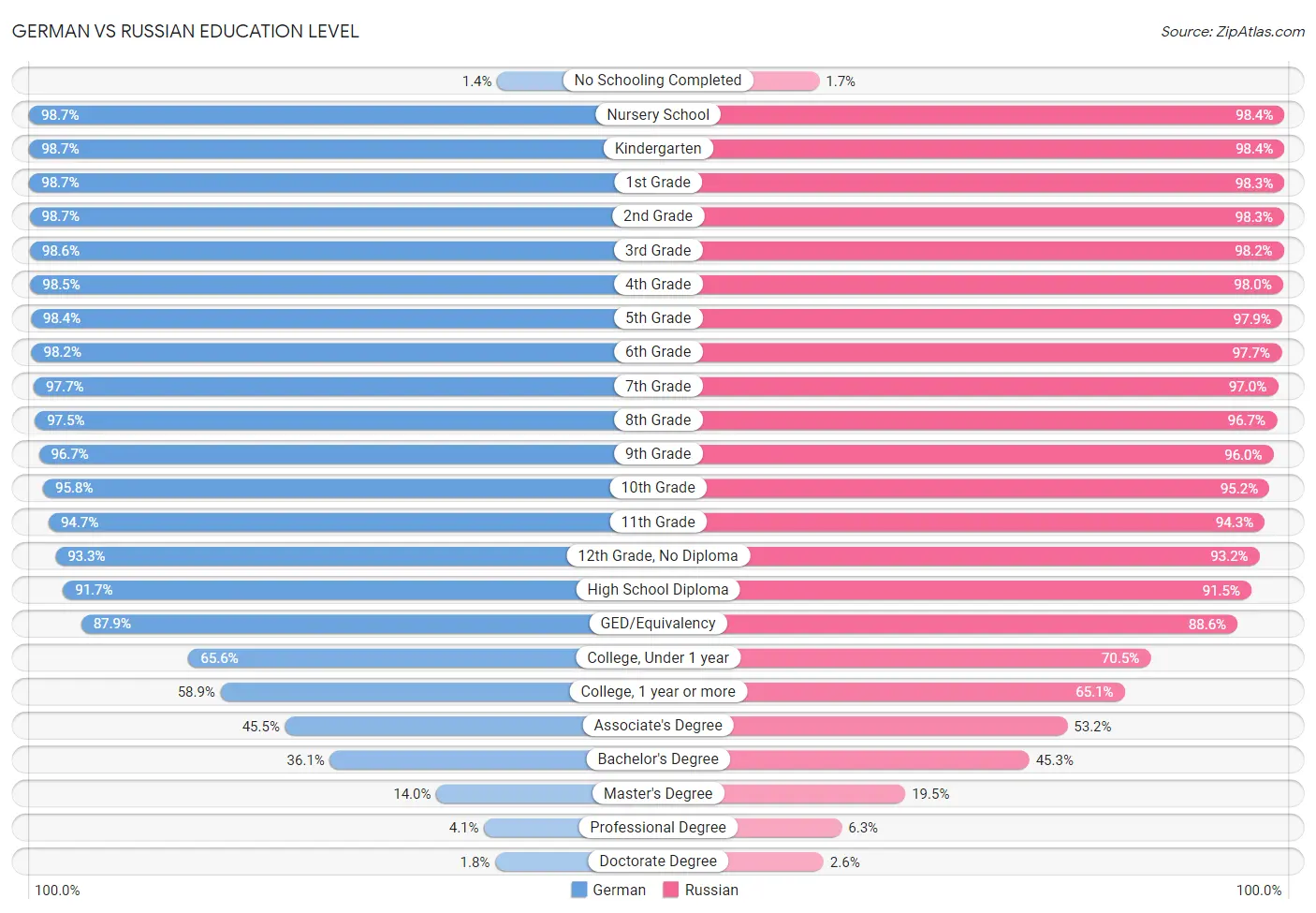
| Education Level Metric | German | Russian |
| No Schooling Completed | Exceptional 1.4% | Exceptional 1.7% |
| Nursery School | Exceptional 98.7% | Exceptional 98.4% |
| Kindergarten | Exceptional 98.7% | Exceptional 98.4% |
| 1st Grade | Exceptional 98.7% | Exceptional 98.3% |
| 2nd Grade | Exceptional 98.7% | Exceptional 98.3% |
| 3rd Grade | Exceptional 98.6% | Exceptional 98.2% |
| 4th Grade | Exceptional 98.5% | Exceptional 98.0% |
| 5th Grade | Exceptional 98.4% | Exceptional 97.9% |
| 6th Grade | Exceptional 98.2% | Exceptional 97.7% |
| 7th Grade | Exceptional 97.7% | Exceptional 97.0% |
| 8th Grade | Exceptional 97.5% | Exceptional 96.7% |
| 9th Grade | Exceptional 96.7% | Exceptional 96.0% |
| 10th Grade | Exceptional 95.8% | Exceptional 95.2% |
| 11th Grade | Exceptional 94.7% | Exceptional 94.3% |
| 12th Grade, No Diploma | Exceptional 93.3% | Exceptional 93.2% |
| High School Diploma | Exceptional 91.7% | Exceptional 91.5% |
| GED/Equivalency | Exceptional 87.9% | Exceptional 88.6% |
| College, Under 1 year | Average 65.6% | Exceptional 70.5% |
| College, 1 year or more | Fair 58.9% | Exceptional 65.1% |
| Associate's Degree | Fair 45.5% | Exceptional 53.2% |
| Bachelor's Degree | Poor 36.1% | Exceptional 45.3% |
| Master's Degree | Poor 14.0% | Exceptional 19.5% |
| Professional Degree | Poor 4.1% | Exceptional 6.3% |
| Doctorate Degree | Fair 1.8% | Exceptional 2.6% |
German vs Russian Disability
When considering disability, the most significant differences between German and Russian communities in the United States are seen in disability age under 5 (1.7% compared to 1.4%, a difference of 25.8%), disability age 35 to 64 (12.3% compared to 10.2%, a difference of 20.7%), and disability age 18 to 34 (7.7% compared to 6.5%, a difference of 18.0%). Conversely, both communities are more comparable in terms of self-care disability (2.4% compared to 2.4%, a difference of 0.76%), cognitive disability (16.7% compared to 16.4%, a difference of 1.5%), and disability age over 75 (46.3% compared to 45.5%, a difference of 1.7%).
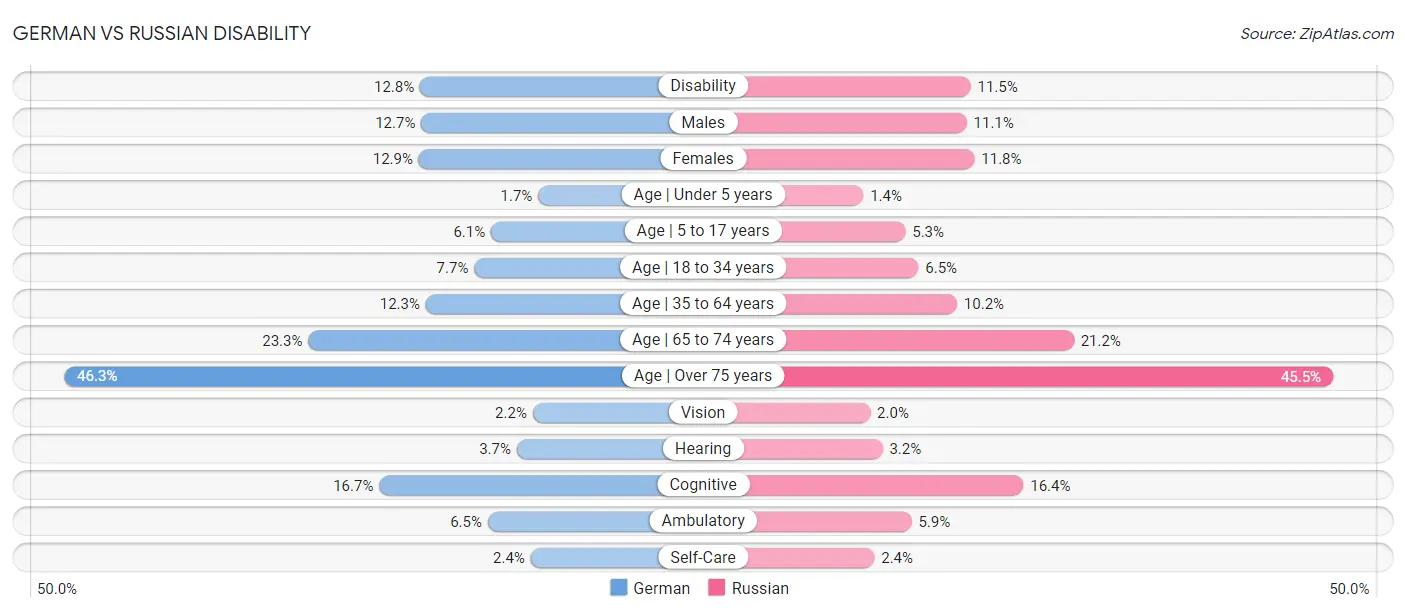
| Disability Metric | German | Russian |
| Disability | Tragic 12.8% | Excellent 11.5% |
| Males | Tragic 12.7% | Good 11.1% |
| Females | Tragic 12.9% | Exceptional 11.8% |
| Age | Under 5 years | Tragic 1.7% | Tragic 1.4% |
| Age | 5 to 17 years | Tragic 6.1% | Exceptional 5.3% |
| Age | 18 to 34 years | Tragic 7.7% | Good 6.5% |
| Age | 35 to 64 years | Tragic 12.3% | Exceptional 10.2% |
| Age | 65 to 74 years | Average 23.3% | Exceptional 21.2% |
| Age | Over 75 years | Exceptional 46.3% | Exceptional 45.5% |
| Vision | Poor 2.2% | Exceptional 2.0% |
| Hearing | Tragic 3.7% | Tragic 3.2% |
| Cognitive | Exceptional 16.7% | Exceptional 16.4% |
| Ambulatory | Tragic 6.5% | Exceptional 5.9% |
| Self-Care | Excellent 2.4% | Excellent 2.4% |